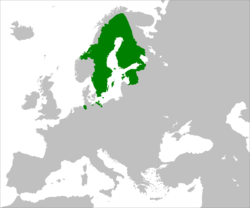Swedish Empire
This article does not have any sources. (April 2011) |
Swedish Empire Kingdom of Sweden Det svenska stormaktsväldet Konungariket Sverige | |||||||
|---|---|---|---|---|---|---|---|
| 1611–1718 | |||||||
|
Flag | |||||||
 The Swedish Empire at its height in 1658. Overseas possessions are not shown. | |||||||
| Capital | Stockholm | ||||||
| Common languages | Swedish, Finnish, Norwegian, Estonian, Sami, German, Livonian, Latvian, Danish | ||||||
| Religion | Lutheranism (Eastern orthodox faith recognized as minority religion) | ||||||
| Government | Monarchy | ||||||
| King | |||||||
• 1611–1632 | Gustav II Adolf the Great | ||||||
• 1632–1654 | Christina | ||||||
• 1654–1660 | Charles X Gustav | ||||||
• 1660–1697 | Charles XI | ||||||
• 1697–1718 | Charles XII | ||||||
| Lord High Chancellor | |||||||
• 1612–1654 | Axel Oxenstierna | ||||||
• 1654–1656 | Erik Oxenstierna | ||||||
• 1660–1686 | Magnus Gabriel De la Gardie | ||||||
| Legislature | Riksdag of the Estates | ||||||
| Historical era | Early modern Europe | ||||||
• Established | 1611 | ||||||
• Disestablished | 1718 | ||||||
| Population | |||||||
• 17th century | 2500000 | ||||||
| Currency | Riksdaler, Mark (until 1664), Carolin (from 1664) | ||||||
| |||||||
| Today part of | |||||||
The Swedish Empire in European history, was important between the years 1611 and 1718. In Swedish it is called "stormaktstiden" meaning "the era of great power"). King Gustavus Adolphus was king from 1611. Europe was full of political, religious, and military conflicts. The Thirty Years' War (1618-1648) and Second Northern War gave Sweden opportunities to expand its influence.
History[change | change source]
Rise to power[change | change source]
King Gustavus Adolphus made Sweden powerful. The Swedish military had strong infantry and he led them cleverly. Victories such as the Battle of Breitenfeld in 1631 made Sweden strong.
Notable achievements[change | change source]
During this period, Sweden advanced in science, culture, and trade. In Stockholm the Swedish Academy was started in 1786.This was important for the development of Swedish language and literature. The empire made possible colonization efforts, including the foundation of New Sweden in North America. The empire's control over key Baltic trade routes helped its economic prosperity. Sweden's urban centers saw the emergence of grand architecture, vibrant arts, and a flourishing cultural scene.
Decline and the Great Northern War[change | change source]
The empire declined because of the Great Northern War (1700-1721). Sweden fought against an alliance of powers including Russia, Denmark-Norway, and Poland-Lithuania. It lost several territories, marking the end of its imperial era.
Related pages[change | change source]

